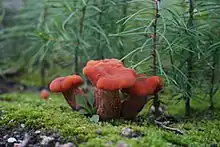Laccaria
Laccaria is a genus around 75 species of fungus found in both temperate and tropical regions of the world.[1][2] They are mycorrhizal. The type species is Laccaria laccata, commonly known as the deceiver. Other notable species include L. bicolor, and the amethyst deceiver (L. amethystina), sometimes incorrectly written as L. amethystea. Because some Laccaria species have the ability to grow vegetatively and/or germinate from basidiospores in culture, they are often used as experimental systems for studies of ectomycorrhizal basidiomycetes.[3] They have a tetrapolar mating system, meaning that there the mating type is controlled by 2 loci. Recently, the genome of L. bicolor has been sequenced.[4]
| Laccaria | |
|---|---|
 | |
| Laccaria bicolor | |
| Scientific classification | |
| Domain: | Eukaryota |
| Kingdom: | Fungi |
| Division: | Basidiomycota |
| Class: | Agaricomycetes |
| Order: | Agaricales |
| Family: | Hydnangiaceae |
| Genus: | Laccaria Berk. & Broome |
| Type species | |
| Laccaria laccata | |
| Species | |
|
See text | |
Description
Laccaria typically have thick, widely spaced, purple to flesh-colored gills that are adnate to slightly decurrent in attachment. The spores are white and ornamented in most species.[5]
Selected species
The following is an incomplete list of Laccaria species reported in the literature:
- Laccaria amethysteo-occidentalis
- Laccaria amethystina
- Laccaria alba
- Laccaria angustilamella
- Laccaria aurantia – China[6]
- Laccaria bicolor
- Laccaria chibinensis - Russia
- Laccaria fraterna
- Laccaria fulvogrisea – China[6]
- Laccaria gomezii
- Laccaria japonica – Japan[7]
- Laccaria laccata
- Laccaria longipes
- Laccaria maritima
- Laccaria montana
- Laccaria moshuijun – China[7]
- Laccaria nobilis
- Laccaria ochropurpurea
- Laccaria paraphysata
- Laccaria proxima
- Laccaria pseudomontana
- Laccaria purpureobadia
- Laccaria tetraspora
- Laccaria tortilis
- Laccaria vinaceobrunnea
- Laccaria yunnanensis – China[6]
Gallery
 Laccaria amethystina
Laccaria amethystina Laccaria bicolor
Laccaria bicolor Laccaria laccata
Laccaria laccata Laccaria proxima
Laccaria proxima
References
- Kirk PM, Cannon PF, Minter DW, Stalpers JA (2008). Dictionary of the Fungi (10th ed.). Wallingford: CABI. p. 357. ISBN 978-0-85199-826-8.
- Mueller GM. (1985). Numerical taxonomic analyses on Laccaria (Agaricales). Mycologia 77: 121-129.
- Podila GK, Zheng J, Balasubramanian S, Sundaram S, Hiremath S, Brand JH, Hymes MJ. (2002). Fungal gene expression in early symbiotic interactions between Laccaria bicolor and red pine. Plant and Soil 244: 117–128.
- Martin F, Selosse MA. (2008). The Laccaria genome: a symbiont blueprint decoded. New Phytologist 180(2):296-310.
- Orr, Dorothy B.; Orr, Robert Thomas (1980). Mushrooms of Western North America (California Natural History Guides). Berkeley: University of California Press. ISBN 0-520-03660-3.
- Popa F, Rexer K-H, Donges K, Yang ZL, Kost G (2014). "Three new Laccaria species from Southwest China (Yunnan)". Mycological Progress. 13 (4): 1105–1117. doi:10.1007/s11557-014-0998-7. S2CID 18566097.
- Vincenot L, Popa F, Laso F, et al. (2017). "Out of Asia: Biogeography of fungal populations reveals Asian origin of diversification of the Laccaria amethystina complex, and two new species of violet Laccaria". Fungal Biology. 121 (11): 939–955. doi:10.1016/j.funbio.2017.08.001. PMID 29029701.
External links
![]() Media related to Laccaria at Wikimedia Commons
Media related to Laccaria at Wikimedia Commons
- Mueller, Gregory M. (1984). "New North American species of Laccaria (Agaricales)". Mycotaxon. 20 (1): 101–116. (Archived at: CYBERLIBER: an Electronic Library for Mycology.)
- Mueller, Gregory M. (1992). "Systematics of Laccaria (Agaricales) in the continental United States and Canada, with discussions on extralimital taxa and descriptions of extant types". Fieldiana Botany. 30: 1–158. ISSN 0015-0746. (Archived at: Archive.org.)
- Mueller, Gregory M. (1997). "The mushroom genus Laccaria in North America". Archived from the original on 2009-03-17. Field Museum of Natural History. Retrieved 2010-12-12.